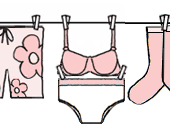
Nutrition Basics for Adults and Older Adults
Posted in Nutrition on August 10, 2014 by FloridaHealth.com staff. Last modified on December 02, 2018. Read disclaimer.
As a child, you were probably told that you needed to eat a balanced diet so that you would grow up strong and tall. From middle age on, however, you still need to eat a balanced diet. Adults aren't eating to support growth particularly, but to maintain health and to repair tissues.
The fact is, eating nutritiously is one of the best things we can do to promote health.
What's a healthy diet for adults?
You can start with the USDA's Dietary Guidelines for Americans:
- Eat a wide variety of foods.
- Maintain a healthy weight.
- Avoid too much fat, saturated fat, and cholesterol.
- Eat plenty of fruits, vegetables, and whole grains.
- Avoid too much sugar.
- Avoid too much sodium.
- If you drink alcoholic beverages, do so in moderation.
Those are the basics for healthful eating. Now let's take a look at some of the specifics.
+ Free Shipping & Returns on Eligible Items.
(*Amazon's Top 100 list updated hourly.)
Calories
As you become less active and lose muscle tissue, you need fewer calories. Body metabolism slows with age, further decreasing your need for calories.
If you have put on extra pounds over the years, the best way to lose unwanted weight is to eat less and exercise more. It can be difficult to change the habits of a lifetime, but maintaining a proper weight is important to your overall health.
Work on eating a balanced diet and limit those "empty" calories, the ones you get from fattening foods that have few vitamins and minerals. For example, if you substitute fresh fruit for a piece of cake, you save 300 calories.
If your caloric intake is already quite low and you still need to lose weight, try becoming more active. Walking as little as one mile can use about 100 calories. Besides making you feel better, regular exercise maintains muscle tone, promotes strong bones, reduces stress and blood pressure, and helps prevent constipation.
Carbohydrates
Try to get 50 to 60 percent of your calories from fruits, vegetables, and whole-grain products. These complex carbohydrates provide fiber, water, vitamins, and minerals without a lot of fat.
Fiber is especially important in protecting against heart disease and colon and rectal cancer, in treating diabetes, and in decreasing constipation.
Protein
You need as much protein now as you did when you were 25. Women need about 50 grams and men about 63 grams of protein a day. Protein should supply 12 to 14 percent of your total calories. Eat 4 to 6 ounces of meat or the equivalent in meat alternatives each day. Since you don't need too much fat in your meals, choose lean meat, fish and poultry, and low-fat dairy products. Meat alternatives, such as dried beans and peas, are good low-fat sources of protein.
Your need for more protein will be higher than normal if you have a health problem like an infection or injury. Extra protein always is needed during the healing process.
Fat
Watch out for too much fat in your diet. Besides being high in calories, too much fat in the diet has been linked to the development of heart disease, cancer, obesity, and other problems. Also, many people find fatty foods hard to digest.
Fluids
It is easy to become dehydrated. You need 8 cups of liquid every day. This should include 2 or 3 glasses of water; other drinks and foods will make up the rest of the liquids.
You may not drink enough fluids unless you keep track. Here's a trick that many people have found useful. Set aside eight small objects in a cabinet. Each time you drink a cup of liquid, take one of the objects out. In the evening, check to make sure all of the objects are out.
Make a habit of drinking liquids at meals. Liquids help you to swallow, and they aid in digestion and kidney function.
Vitamins
As you get older, your need for vitamins changes. Generally, you need less vitamin A and folate, and more vitamins D, B-6 and B12. Eating a balanced, varied diet with foods from each of the food groups, especially fruits, vegetables, and whole grains, is the best way to obtain the vitamins needed. Take vitamin supplements only if your doctor prescribes them.
Minerals
As you age, your body has more difficulty absorbing iron and calcium. Deficiencies of these minerals are associated with anemia and osteoporosis.
If you are cutting back on calories or eating less meat and poultry, you may not get enough zinc. A deficiency of this mineral affects your sense of taste, immunity to disease, and ability to heal. A well-balanced diet generally will ensure that a mineral deficiency does not occur. However, certain foods are higher in particular minerals, and emphasizing them in your diet can help.
For calcium, the best sources are milk, yogurt, and cheese. (Choose low-fat products if possible.) If you have trouble digesting milk, Calcimilk, sweet acidophilus milk, Lactaid, or buttermilk may be substituted.
For iron, enriched breads, whole grain cereals, liver, organ meats, eggs, and leafy green vegetables are good sources. Your body will absorb iron better if you eat a food high in vitamin C at the same time. For examp1e, drink a glass of orange juice with your whole grain cereal.
For zinc, seafood, red meats, poultry, milk, whole-grain products, nuts, and legumes are good sources.
How to develop healthy eating habits
Make a habit of eating regular, balanced meals rather than snacking. Include a variety of foods in adequate portions to provide what you need each day. Choose from the four food groups for each meal. Use fresh fruits and vegetables in season and serve them raw with peels when appropriate.
Daily Food Guide for Healthy Adults |
||
| Food Group | Portion Size (one serving) | Servings Needed Per Day |
|---|---|---|
| Milk, Yogurt and Cheese | 1 cup milk or yogurt; 1 1/2 ounces of natural cheese; 2 ounces of processed cheese | 2-3 |
| Meat, Poultry, Fish, Dry Beans, Eggs and Nuts | 2 to 3 ounces of cooked lean, boneless meat, poultry, or fish; 1 egg or 1/2 cup cooked dry beans or peas or 2 tablespoons peanut butter count as 1 ounce of lean meat | 2-3 |
| Fruit | 1/2 cup of chopped, cooked or canned fruit; or 1 medium apple, banana, or orange; or 3/4 cup of fruit juice | 2-4* |
| Vegetable | 1 cup raw vegetables; 1/2 cup of other vegetables, cooked or raw; 3/4 cup of vegetable juice | 3-5* |
| Bread, Cereal, Rice and Pasta | 1 slice of bread or 1 ounce ready-to-eat cereal or 1/2 cup cooked cereal or pasta or 5 saltines or 2 squares graham crackers | 6-11 (Whole-grain, enriched products) |
| Fats, Oils and Sweets | Use sparingly | None |
*One rich in vitamin A from either group every other day; one rich in vitamin Q from either group every day.
Fitting It All Together
Now that you know the basics, the next step is to put your knowledge to work. The best way is to follow a daily food guide that shows food groups, portion sizes, and the number of servings needed, like the guide above.
Keep a Record
The best way to see how well you are doing nutritionally is to keep a record of what you eat. List the six categories:
- Bread, Cereal, Rice and Pasta
- Fruit
- Vegetable
- Milk, Yogurt and Cheese
- Meat, Poultry, Fish, Dry Beans, Eggs and Nuts
- Fats, Oils and Sweets
Take a typical day and put a check after the appropriate category for each serving you consume. For example, if you have a cup of skim milk, check "Milk, Yogurt and Cheese."
At the end of the day, total the servings from each category. Your totals in each category should equal the minimum number of servings suggested in the Daily Food Guide for Healthy Adults above. Limit fats, oils, and sweets.
Meal Plans |
||
| |
Basic Plan | Sample Menu (1,600 Calories) |
|---|---|---|
| Breakfast | 1 serving citrus fruit 2 servings bread 1 fat (an extra) 1 sugar (an extra) 1 serving milk |
1/2 cup orange juice 1 cup cereal 1 slice toast with 1 teaspoon margarine and 1 tablespoon jelly 1 cup skim milk 1 cup coffee or tea |
| Noon meal | 1 serving meat 2 servings bread 1 serving fat (an extra) 1 serving fruit 1 serving vegetable 1 serving milk |
tuna fish salad sandwich with lettuce and tomato slices medium apple 1 cup skim milk |
| Afternoon snack | beverage | tea |
| Evening Meal | 1 serving meat 2 servings vegetables 2 servings bread 1 fat (an extra) beverage 1/2 serving milk |
3 ounces lean ground beef patty 1/2 cup broccoli 1/2 cup carrots 1/2 cup pork and beans 1 dinner roll 1 teaspoon margarine glass of iced tea 1/2 cup frozen low-fat yogurt |
| Snacks | 1 serving fruit 2 beverages |
1 cup watermelon water |
If you are having trouble planning out the day's menu, take a look at the chart above. The suggested meal plans follow the daily food guide. Use the basic plan to organize your daily menus.
Primary source for this post:
Dietary Guidelines for Americans, USDA and HHS
Making the Last Half the Best Half, Jacquelyn W. McClelland, Extension Foods and Nutrition Specialist, North Carolina Cooperative Extension Service

 Germiest items in your home | Quiz
Germiest items in your home | Quiz When to wash clothes | Infographic
When to wash clothes | Infographic How to select, ripen and enjoy healthy avocados
How to select, ripen and enjoy healthy avocados Potty training tips for girls and boys
Potty training tips for girls and boys Home & yard mosquito control | Infographic
Home & yard mosquito control | Infographic 9 Beauty secrets to younger-looking skin
9 Beauty secrets to younger-looking skin Dietary needs of adults and older adults
Dietary needs of adults and older adults Can cranberry juice prevent urinary tract infections?
Can cranberry juice prevent urinary tract infections? 9 Foods that are delicious and super nutritious
9 Foods that are delicious and super nutritious What works (and what doesn't) for hangovers
What works (and what doesn't) for hangovers Tips for preventing or treating sunburns
Tips for preventing or treating sunburns Foods that are high in calcium for healthy bones
Foods that are high in calcium for healthy bones Action plan for getting rid of cockroaches
Action plan for getting rid of cockroaches What causes body odor and how to prevent it
What causes body odor and how to prevent it Important tips for preventing heart disease
Important tips for preventing heart disease Ha! Try this funny technique for managing stress
Ha! Try this funny technique for managing stress How to prevent and remove mold and mildew
How to prevent and remove mold and mildew Container gardening ideas
Container gardening ideas What is cholesterol and tips for managing it
What is cholesterol and tips for managing it